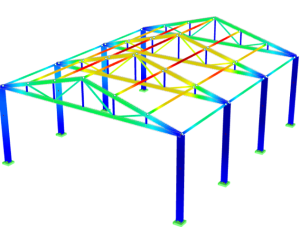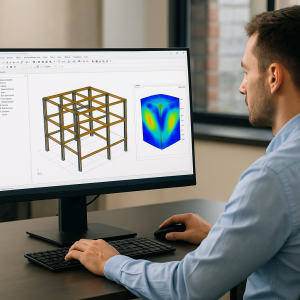3D printing in construction, also known as additive manufacturing, refers to the process of creating three-dimensional building components or entire structures using digital models and specialized materials. Unlike traditional subtractive construction methods, 3D printing builds objects layer by layer, often using robotic arms or gantry-based printers to deposit material with extreme precision.
This technology has evolved from small-scale prototypes to full-scale housing, bridges, and infrastructure components, offering a highly innovative approach to construction that is faster, more sustainable, and often more cost-effective. The use of 3D printing in the construction sector is not just about replacing traditional methods—it’s about reimagining what’s possible in architecture, engineering, and project delivery.
Additive manufacturing reduces complexity in execution while increasing the potential for unique, functional designs that are difficult or impossible to achieve using traditional formwork and casting techniques. The use of Building Information Modeling (BIM) integrated with 3D printing adds another layer of value by allowing for ultra-precise fabrication based on digital twin data.
Advantages of 3D Printing for Structural Design
Design Freedom
Complex geometries, parametric forms, and non-linear structures that were previously impractical or extremely expensive to produce are now within reach. Architects and engineers can take full advantage of design optimization tools to create innovative structures that meet both aesthetic and functional requirements.
Speed and Efficiency
3D printing allows for faster on-site construction, significantly reducing project timelines. In many instances, a small building can be completed in under 24–48 hours. This is particularly valuable in emergency housing, disaster response, and rapid urban expansion.
Cost Savings
While initial equipment costs are high, long-term savings are substantial due to reduced labor requirements, fewer material costs, and less time on site. Also, the minimal use of molds or formwork lowers expenses and reduces complexity.
Customization
Each unit or component can be tailored without added cost, making it ideal for individualized housing, modular buildings, or infrastructure adapted to specific site conditions. Engineers can optimize designs based on topography, load conditions, or user needs without retooling.
Material Efficiency
3D printing allows precise control of material placement, reducing waste by up to 60% compared to traditional methods. This is especially critical in projects where sustainability and environmental impact are priorities.
Fewer Construction Accidents
With fewer workers needed on site and heavy lifting done by machines, the risk of workplace injuries is significantly reduced.
Key Technologies and Materials Used
Technologies
- Concrete 3D Printing (Contour Crafting): One of the most widely used methods. This technique employs a robotic system that extrudes a concrete mixture in layers. It has been used for constructing walls, floors, and even entire homes.
- Binder Jetting: A layer of powder material is deposited, and a binding agent is applied selectively. While not as strong as extrusion printing, it’s excellent for detailed or smaller architectural elements.
- Extrusion-Based Printing: This is a more flexible and scalable method. It allows for different nozzle sizes, multiple materials, and various curing systems, making it adaptable to numerous applications.
- Sand Printing: Used primarily for molds in concrete casting, this method allows rapid and cost-effective creation of complex molds.
Materials
- Concrete Mixes: These are specially formulated with additives to enhance flowability, quick setting, and structural strength.
- Polymers and Resins: Ideal for fine details, window frames, and architectural décor.
- Fiber-Reinforced Materials: These include carbon, basalt, or glass fibers to increase tensile strength and crack resistance.
- Geopolymer Cements: A sustainable alternative to Portland cement, geopolymer-based materials have low carbon emissions and are often made from industrial byproducts like fly ash or slag.
ALT Text 1: Robotic arm printing layers of concrete in a 3D-printed house foundation.
Case Study: ICON’s 3D-Printed Homes in Mexico
In 2020, construction technology company ICON partnered with New Story, a nonprofit focused on housing, to build the world’s first 3D-printed community in Tabasco, Mexico. This groundbreaking project provided housing for families who previously lived in inadequate conditions.
Project Highlights:
- Scope: 50 homes, each around 500 square feet
- Duration: Each home was printed in approximately 24 hours spread across several days
- Technology Used: Vulcan II printer with Lavacrete (a proprietary concrete mix)
- Impact: High durability, resilience to earthquakes and floods, and significant cost savings
This project proved that 3D printing can be scaled for real-world applications, especially in low-income housing. It also set the precedent for using technology as a solution to housing shortages.
Another key example is the Eindhoven 3D-printed homes project in the Netherlands, where five houses were constructed using a cement-based 3D printer. The first residents moved in during 2021, highlighting the practicality of this technology for urban living.

Sustainability Benefits of 3D Printing
Sustainability is a central pillar in modern construction. 3D printing contributes to this goal in several ways:
Waste Reduction
Traditional construction generates an estimated 30% waste on-site. 3D printing reduces this to below 10%, making it highly efficient.
Reduced Transportation
3D printing allows for on-site manufacturing, eliminating the need for transporting prefabricated materials and reducing CO2 emissions.
Green Materials
Many firms are experimenting with biodegradable or recycled composites. For example, WASP in Italy has printed homes using clay, straw, and agricultural waste.
Lifecycle Performance
3D-printed structures are being designed with end-of-life considerations. Materials can be reclaimed and reused in new projects.
Challenges in Adoption
Despite growing interest, several hurdles still need to be addressed:
Code Compliance
Most construction codes are written with traditional methods in mind. It’s a challenge to get 3D-printed structures approved for occupancy, especially in urban or regulated zones.
Technology Access and Cost
The cost of industrial 3D printers, along with maintenance and training, limits adoption for small and mid-sized contractors.
Material Certification
Building authorities require standardized test data on material performance—something still under development for many new 3D printing materials.
Skill Gaps
There’s a shortage of engineers and architects trained in both digital fabrication and structural engineering principles.
Future of 3D Printing in Engineering
Looking ahead, several trends indicate that 3D printing will become a core tool in construction:
- Integration with AI and Machine Learning: Systems will adapt in real time to conditions, improving material usage and design reliability.
- On-Site Robotics and Drones: Combining autonomous drones with 3D printers could allow for vertical and remote builds.
- Smart Materials: Materials that change properties in response to environmental factors are under development.
- Global Housing Initiatives: Governments are increasingly funding 3D printing projects to combat homelessness and displacement.
NASA and ESA are also researching 3D printing technologies that use regolith (moon dust) to build habitats on the Moon and Mars—showcasing the universal potential of this innovation.
How to Get Started with 3D Printing in Construction
Education and Certification
Courses in additive manufacturing, offered by institutions like MIT, ETH Zurich, and TU Delft, provide foundational knowledge.
Partnering with 3D Printing Providers
Many companies offer design-to-delivery services, helping clients prototype and build their first printed structures.
Invest in Software and Hardware
Start small with desktop 3D printers or simulation software to experiment with designs and printing methods.
Pilot Projects and Proof-of-Concepts
Consider starting with elements like walls, panels, or fixtures. These smaller tests allow teams to understand the logistics, material behavior, and regulatory landscape.
Join Industry Networks
Organizations like ASTM International and the 3D Printing Construction Alliance offer resources, case studies, and events.
Conclusion
3D printing is not just an emerging trend—it’s a technological revolution that’s redefining the rules of construction. From reducing waste and cost to enabling architectural freedom and addressing housing shortages, its benefits are far-reaching.
Though challenges remain, the combination of technological advancement, sustainable practices, and increasing demand for faster, cheaper, and greener buildings ensures that 3D printing will have a central role in the future of construction and structural engineering.
Stay connected with Avesta Consulting to explore how you can be part of this exciting transformation.




